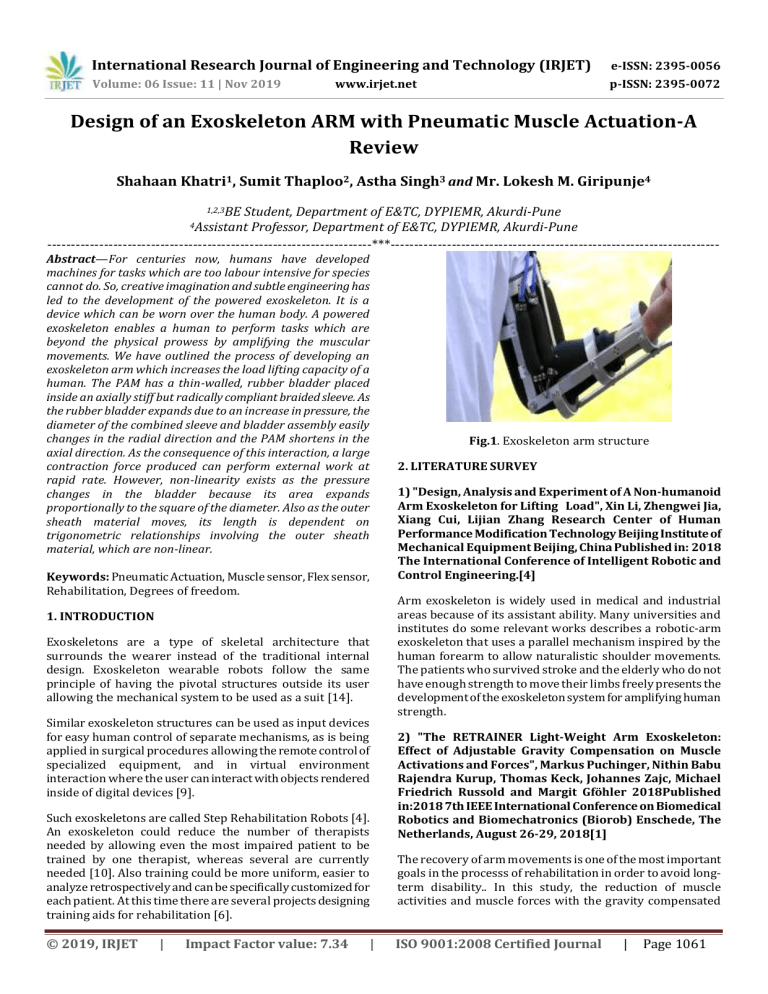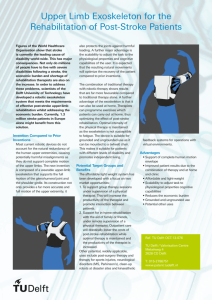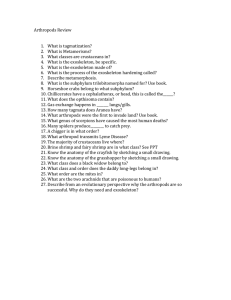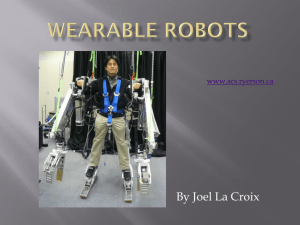IRJET- Design of an Exoskeleton ARM with Pneumatic Muscle Actuation-A Review
advertisement

International Research Journal of Engineering and Technology (IRJET) e-ISSN: 2395-0056 Volume: 06 Issue: 11 | Nov 2019 p-ISSN: 2395-0072 www.irjet.net Design of an Exoskeleton ARM with Pneumatic Muscle Actuation-A Review Shahaan Khatri1, Sumit Thaploo2, Astha Singh3 and Mr. Lokesh M. Giripunje4 1,2,3BE Student, Department of E&TC, DYPIEMR, Akurdi-Pune Professor, Department of E&TC, DYPIEMR, Akurdi-Pune ---------------------------------------------------------------------***---------------------------------------------------------------------4Assistant Abstract—For centuries now, humans have developed machines for tasks which are too labour intensive for species cannot do. So, creative imagination and subtle engineering has led to the development of the powered exoskeleton. It is a device which can be worn over the human body. A powered exoskeleton enables a human to perform tasks which are beyond the physical prowess by amplifying the muscular movements. We have outlined the process of developing an exoskeleton arm which increases the load lifting capacity of a human. The PAM has a thin-walled, rubber bladder placed inside an axially stiff but radically compliant braided sleeve. As the rubber bladder expands due to an increase in pressure, the diameter of the combined sleeve and bladder assembly easily changes in the radial direction and the PAM shortens in the axial direction. As the consequence of this interaction, a large contraction force produced can perform external work at rapid rate. However, non-linearity exists as the pressure changes in the bladder because its area expands proportionally to the square of the diameter. Also as the outer sheath material moves, its length is dependent on trigonometric relationships involving the outer sheath material, which are non-linear. Keywords: Pneumatic Actuation, Muscle sensor, Flex sensor, Rehabilitation, Degrees of freedom. 1. INTRODUCTION Exoskeletons are a type of skeletal architecture that surrounds the wearer instead of the traditional internal design. Exoskeleton wearable robots follow the same principle of having the pivotal structures outside its user allowing the mechanical system to be used as a suit [14]. Similar exoskeleton structures can be used as input devices for easy human control of separate mechanisms, as is being applied in surgical procedures allowing the remote control of specialized equipment, and in virtual environment interaction where the user can interact with objects rendered inside of digital devices [9]. Such exoskeletons are called Step Rehabilitation Robots [4]. An exoskeleton could reduce the number of therapists needed by allowing even the most impaired patient to be trained by one therapist, whereas several are currently needed [10]. Also training could be more uniform, easier to analyze retrospectively and can be specifically customized for each patient. At this time there are several projects designing training aids for rehabilitation [6]. © 2019, IRJET | Impact Factor value: 7.34 | Fig.1. Exoskeleton arm structure 2. LITERATURE SURVEY 1) "Design, Analysis and Experiment of A Non-humanoid Arm Exoskeleton for Lifting Load", Xin Li, Zhengwei Jia, Xiang Cui, Lijian Zhang Research Center of Human Performance Modification Technology Beijing Institute of Mechanical Equipment Beijing, China Published in: 2018 The International Conference of Intelligent Robotic and Control Engineering.[4] Arm exoskeleton is widely used in medical and industrial areas because of its assistant ability. Many universities and institutes do some relevant works describes a robotic-arm exoskeleton that uses a parallel mechanism inspired by the human forearm to allow naturalistic shoulder movements. The patients who survived stroke and the elderly who do not have enough strength to move their limbs freely presents the development of the exoskeleton system for amplifying human strength. 2) "The RETRAINER Light-Weight Arm Exoskeleton: Effect of Adjustable Gravity Compensation on Muscle Activations and Forces", Markus Puchinger, Nithin Babu Rajendra Kurup, Thomas Keck, Johannes Zajc, Michael Friedrich Russold and Margit Gföhler 2018Published in:2018 7th IEEE International Conference on Biomedical Robotics and Biomechatronics (Biorob) Enschede, The Netherlands, August 26-29, 2018[1] The recovery of arm movements is one of the most important goals in the processs of rehabilitation in order to avoid longterm disability.. In this study, the reduction of muscle activities and muscle forces with the gravity compensated ISO 9001:2008 Certified Journal | Page 1061 International Research Journal of Engineering and Technology (IRJET) e-ISSN: 2395-0056 Volume: 06 Issue: 11 | Nov 2019 p-ISSN: 2395-0072 www.irjet.net RETRAINER upper limb exoskeleton were analyzed carrying out defined movements with healthy subjects. 3) "Design of Exoskeleton Arm for Enhancing Human Limb Movement ", Thunyanoot Prasertsakul, Teerapong Sookjit, and Warakorn Charoensuk Published in: Proceedings of the 2011 IEEE International Conference on Robotics and Biomimetics December 7-11, 2011, Phuket, Thailand[5] Human motion is an important function which is related to the movement of the limbs. Patients who have injured or damaged of brain will be lost the movement function. The designed exoskeleton arm has degrees-of-freedom. Three degrees-of-freedom are at the shoulder joint, i.e. flexion/extension. The elbow joint has two degrees-of freedom that are flexion/extension and supination / pronation. Controlling the exoskeleton arm can be performed by the signals and a set of controller which composes of the electromyography amplifier, analog to digital convertor, motor control and motor driver. 4) "Improvement of Upper Extremity Rehabilitation Robotic Exoskeleton, NREX ",Won-Kyung Song and JunYong Song Department of Rehabilitative and Assistive Technology, National Rehabilitation Center, Published in:2017 14th International Conference on Ubiquitous Robots and Ambient Intelligence (URAI) June 28 - July 1, 2017 at Maison Glad Jeju, Jeju, Korea[10] The NRC Robotic Exoskeleton (NREX), developed by the National Rehabilitation Center (NRC), is a lightweight, exoskeleton robot capable of assisting movements related to daily life activities. NREX has an exercise function for movements of hands and arm via minimal number of electrical motors. It is based on the movement of one wrist joint and one elbow joint. Additionally, NREX has a hand grip function. 5) "Design of Exoskeleton Robotic Hand/Arm System for Upper Limbs Rehabilitation Considering Mobility and Portability ", Yong-Kwun Lee Department of Biorobotics, Kyushu Sangyo University, Fukuoka, 813-8503, Japan Published in:The 11th International Conference on Ubiquitous Robots and Ambient Intelligence (URAI 2014) Nov. 12-15, 2014 at Double Tree Hotel by Hilton, Kuala Lumpur, Malaysia[8] Hand and arm movement disorders can be caused by stroke, fractures, ligament tear or loss of strength due to aging. Stroke is a disease accompanying partial paralysis in the muscle contraction and expansion, but stroke patients can be improved by rehabilitation training or physiotherapy. To increase the effectiveness of rehabilitation training, continuous and repeated movement training with a physiotherapist is needed and enhancement can be achieved in the process by using such designs. © 2019, IRJET | Impact Factor value: 7.34 | 6) "Design and Analysis of Upper Arm Exoskeleton with Virtual Reality based Motion Tracking Capabilities ", Faisal Khalid Kayshan, Hassan Othayman Al-Qahtani[11] Many patients are suffering from paralyzing diseases and to follow the higher demand for patients needs to develop mechanical devices which will help them to perform their regular activities, exoskeleton devices are designed to fulfil the gap in medical rehabilitation. Exoskeleton is the new phase for medical rehabilitation compared to other rehabilitation robots that limited to clinical use only. The application of an exoskeleton includes: 1) an assistive device (human amplifier), 2) a physiotherapy device, 3) a master device, 4) a haptic device. 7) "Exoskeleton Arm ", Pooja Jha ,Kinjal Savla, Dishant Shah ,Department of Electronics and Telecommunication D. J. Sanghvi College of Engineering Mumbai, India [14] In this paper, we propose the design of an efficient and comfortable option to commercial exoskeletons. Exoskeleton here refers to any wearable framework on the human body which eases and supports the muscles to perform work with lesser strain and greater comfort, using mechanical actuators and electrical power. The design proposed shall be capable of sensing the incentive to perform basic work procedures and routines making it natural and comfortable for the user to interact with and utilize this device, increasing its effectiveness and efficiency. 8) "Design of a Haptic Arm Exoskeleton for Training and Rehabilitation", Abhishek Gupta, Student Member, IEEE, and Marcia K. O’Malley, Member, IEEE[6] Quality haptic interface is typically characterized by low apparent inertia and damping, high structural stiffness, minimal backlash, and absence of mechanical singularities in the workspace. In addition to these specifications, exoskeleton haptic interface design involves consideration of space and weight limitations, workspace requirements, and the kinematic constraints placed on the device by the human arm. These constraints impose conflicting design requirements on the engineer attempting to design an arm exoskeleton. In this paper, the authors present a detailed review of the requirements and constraints that are involved in the design of a high-quality haptic arm exoskeleton. 9) "ChARMin: The first actuated exoskeleton robot for pediatric arm rehabilitation ", Urs Keller, Hubertus J. A. van Hedel, Verena Klamroth-Marganska and Robert Riener[13] ChARMin is the first actuated exoskeleton robot for pediatric arm rehabilitation. The device was specifically designed to provide intensive rehabilitative training for children with affected arm motor function, e.g., due to cerebral palsty, therewith complementing conventional therapies. ISO 9001:2008 Certified Journal | Page 1062 International Research Journal of Engineering and Technology (IRJET) e-ISSN: 2395-0056 Volume: 06 Issue: 11 | Nov 2019 p-ISSN: 2395-0072 www.irjet.net 10) "PID Control forth Robotic Exoskeleton Arm: Application to Rehabilitation", GuangyeLiang, WenjunYe, QingXie[7] This paper enlights the PID control of exoskeleton robot armused for assisted rehabilitation. The developed exoskeleton arm consists of 5 joints, which process merits of back drivability, precise positioning capabilities and zero backlash due to its embedded Harmonic drive transmission (HDT) and Elmo driver. The experiments are conducted to verify the effectiveness of the proposed system and control approach. 2 2011 Design of Exoskeleton Arm For Enhancing Human Limb Movement[5] 3 2012 PID Control for the Robotic Exoskeleton Arm: Application to Rehabilitation[7] 4 2014 5 2017 Design of Exoskeleton Robotic Hand/Arm System for Upper Limbs Rehabilitation Considering Mobility and Portability[8] PowerAugmentation Control Approach for Arm Exoskeleton Based on Human Muscular Manipulability[9] 6 2017 Improvement of Upper Extremity Rehabilitation Robotic Exoskeleton, NREX[10] 7 2018 Design, Analysis and Experiment 11)"Design, Implementation and Evaluation of a BrainComputer Interface Controlled Mechanical Arm for Rehabilitation", Kiran George, Adrian Iniguez, Hayden Donze and Sheeba Kizhakkumthala[12] Artificial limbs and exoskeletons have been widely used in a many applications. DARPA primarily focuses on developing exoskeletons to aid soldiers in both physical performance skills, survivability and rehabilitation. Robotic arms have been used to assist individuals who have lost the ability to perform everyday task such as walking running etc. 12) "Power-Augmentation Control Approach for Arm Exoskeleton Based on Human Muscular Manipulability", Rok Goljat, Jan Babi, Tadej Petri, Luka Peternel, Jun Morimoto[9] In the past years, robots have been gradually moving from industrial environments into the human daily lives. The main purpose of such robotic systems is to assist humans in various real-life tasks. One of such promising robotic systems are exoskeletons, which are designed to enclose the human body and provide a direct assistance to the motion. The two main applications of exoskeletons are rehabilitation and power augmentation. 13)"Experimental Modelling of Pneumatic Artificial Muscle Systems ", Manthan V. Pawar[2] Pneumatic Artificial Muscles (PAMs) are widely used in humanoid and exoskeletons for force and mobility assistance. PAM technology is currently under study and facing problems such as low efficiency and less actuation. At Robolab Technologies, PAMs are used in our exoskeleton system called Assistive Pneumatic Muscle Arm (APMA) and has countered such problems. 3. COMPARITIVE STUDY Sr. No. 1 Year of Publica tion 2006 © 2019, IRJET Title Methodology Design of a Haptic Arm Exoskeleton for Training and Rehabilitation[6] The design of a fivedegree-of-freedom haptic arm exoskeleton for training and | Impact Factor value: 7.34 | ISO 9001:2008 Certified Journal rehabilitation in virtual environments is presented. Controlling the exoskeleton arm can be performed by the electromyography signals and a set of controller which composes of the electromyography amplifier, analog to digital convertor, motor control and motor driver. The developed exo skeleton arm consists of 5 joints, which process merits of back drivability, precise positioning capabilities, and zero backlash due to its embedded Harmonic drive transmission (HDT) and Elmo driver. light robot aidrobot with three fingers of 9 DOF In this paper the author presents a control method for the exoskeleton arm that takes into account the muscular force manipulability of the human arm. NREX has a hand grip function. The shoulder has three degrees-of-freedom manual joints without electrical actuators. The design and kinematic analysis | Page 1063 8 9 International Research Journal of Engineering and Technology (IRJET) e-ISSN: 2395-0056 Volume: 06 Issue: 11 | Nov 2019 p-ISSN: 2395-0072 2018 2018 of A Nonhumanoid Arm Exoskeleton for Lifting Load[4] Experimental Modelling of Pneumatic Artificial Muscle Systems Designing of Prosthetic Robotic Arm[2] The RETRAINER Light-Weight Arm Exoskeleton: Effect of Adjustable Gravity Compensation on Muscle Activations and Forces[1] www.irjet.net of a 5 DOF upper limb powered robotic exoskeleton for rehabilitation This paper talk about the Pneumatic Artificial Muscles (PAMs) Fig. 2. Proposed Block Diagram 5. OBJECTIVES Humeral rotation and wrist pro are either controlled by residual muscle forces or locked at customized backrest. The objectives of this paper are To reduce human efforts by lifting a certain amount of weight. To help handicap and injured people in rehabilitation. The study will be useful for people in manufacturing and production for Fast and strong movement, comparable to human hand to lift heavy objects. 6. CONCLUSION 4. PROPOSED WORK We were looking at several ways to store energy and actuate movement with a hydraulic system. For storing energy, we looked at different designs of hydraulic accumulators. We wanted a way of slowly storing high pressures and volumes of water in an accumulator, and then being able to release it at once into an actuator. We were looking at storing the water in an elastic container, which would help propel the fluid out when there was a high difference in pressure. For the actuator, we wanted what would basically be a compliant, soft robotics alternative to hydraulic pistons and cylinders. It was when we combined the idea of the elastic accumulator with the actuator that we stumbled onto our main design concept. We figured out that if we used the contracting movement of the elastic as the muscle force, creating a tensile force rather than a compressive force, it could act similarly to an actual biological muscle. At that point, we needed to figure out a way to restrain the elastic so that it can only expand and contract in one dimension. If we were to connect an elastic bladder like it was human bicep, when we filled it with fluid, it would obviously expand in all directions. We figured that if we used a long elastic tube instead of a bladder, surrounded by a wrinkled, inelastic fabric material, the inelastic material would prevent the elastic tube from expanding radically. The proposed exoskeleton arm successfully addresses the issue of expensiveness prominent in the entire exoskeleton industry and implements simple solutions to reduce its costs. It uses safe, portable and efficient power supply which is environmental friendly compared to non-rechargeable batteries. Hence it is clear that there is a huge scope that the exoskeleton industry will gradually emerge to be highly profitable and will make a huge impact the sectors of defense, industry as well as domestic households, if more such cheaper exoskeletons are made. This industry has the potential to be the leading industry in the near future. 7. SCOPE OF THE PAPER In this present competitive world there is huge scarcity of man power, so there must be an alternative to reduce this problem. Even in industrial application it requires more human resources for daily work and load carrying process is more. All these above work cannot done humans. To overcome this situation pneumatic exoskeleton system is adopted to ease the work and minimize stress of prime area for exoskeleton technology, where it can be used for enhanced precision during surgery or as an assist to allow nurses to move heavy patients. REFERENCES [1] Markus Puchinger et al., “The RETRAINER Light-Weight Arm Exoskeleton: Effect of Adjustable Gravity Compensation on Muscle Activations and Forces”, 2018 7th IEEE International Conference on Biomedical Robotics and Biomechatronics (Biorob) Enschede, The Netherlands, August 26-29, 2018 © 2019, IRJET | Impact Factor value: 7.34 | ISO 9001:2008 Certified Journal | Page 1064 International Research Journal of Engineering and Technology (IRJET) e-ISSN: 2395-0056 Volume: 06 Issue: 11 | Nov 2019 p-ISSN: 2395-0072 www.irjet.net [2] Manthan V. Pawar,” Experimental Modelling of Pneumatic Artificial Muscle Systems Designing of Prosthetic Robotic Arm”, 2018 3rd International Conference for Convergence in Technology (I2CT) The Gateway Hotel, XION Complex, Wakad Road, Pune, India. Apr 06-08, 2018 [3] Kuan-Yi Wu, Yin-Yu Su, Ying-Lung Yu, Kuei-You Lin, and Chao-Chieh Lan, Senior Member, IEEE,” Series Elastic Actuation of an Elbow Rehabilitation Exoskeleton with Axis Misalignment Adaptation”, 2017 International Conference on Rehabilitation Robotics (ICORR) QEII Centre, London, UK, July 17-20, 2017. [12] Kiran George, Adrian Iniguez, Hayden Donze and Sheeba Kizhak kumthala,”Design, Implementation and Evaluation of a Brain-Computer Interface Controlled Mechanical Arm for Rehabilitation”. [13] Urs Keller, Hubertus J. A. van Hedel, Verena KlamrothMarganska and Robert Riener,”ChARMin: The first actuated exoskeleton robot for pediatric arm rehabilitation”. [4] Xin Li, Zhengwei Jia, Xiang Cui, Lijian Zhang,” Design, Analysis and Experiment of A Non-humanoid Arm Exoskeleton for Lifting Load”, 2018 the International Conference of Intelligent Robotic and Control Engineering [5] Thunyanoot Prasertsakul, Teerapong Sookjit, and Warakorn Charoensuk, “Design of Exoskeleton Arm for Enhancing Human Limb Movement”, Proceedings of the 2011 IEEE International Conference on Robotics and Biomimetics December 7-11, 2011, Phuket, Thailand [6] Abhishek Gupta, Student Member, IEEE, and Marcia K. O’Malley, Member, IEEE,”Design of a Haptic Arm Exoskeleton for Training and Rehabilitation”, IEEE/ASME TRANSACTIONS ON MECHATRONICS, VOL. 11, NO. 3, JUNE 2006. [7]GuangyeLiang,WenjunYe,QingXie,”PID Control for the Robotic Exoskeleton Arm: Application to Rehabilitation”. [8] Yong-Kwun Lee,”Design of Exoskeleton Robotic Hand/Arm System for Upper Limbs Rehabilitation Considering Mobility and Portability”,The 11th International Conference on Ubiquitous Robots and Ambient Intelligence (URAI 2014) Nov. 12-15, 2014 at Double Tree Hotel by Hilton, Kuala Lumpur, Malaysia [9] Rok Goljat, Jan Babi, Tadej Petri, Luka Peternel, Jun Morimoto,”Power-Augmentation Control Approach for Arm Exoskeleton Based on Human Muscular Manipulability “, 2017 IEEE International Conference on Robotics and Automation (ICRA) Singapore, May 29 - June 3, 2017. [10] Won-Kyung Song and Jun-Yong Song,”Improvement of Upper Extremity Rehabilitation Robotic Exoskeleton, NREX”, 2017 14th International Conference on Ubiquitous Robots and Ambient Intelligence (URAI) June 28 - July 1, 2017 at Maison Glad Jeju, Jeju, Korea. [11] Faisal Khalid Kayshan, Hassan Othayman Al-Qahtani, Elamvazuthi, Momen Tageldeen,S. Parasuraman ,M.K.A. Ahamed Khan,”Design and Analysis of Upper Arm Exoskeleton with Virtual Reality based Motion Tracking Capabilities”. © 2019, IRJET | Impact Factor value: 7.34 | ISO 9001:2008 Certified Journal | Page 1065


